MCB 181: Exam 4 Practice Questions
1/84
There's no tags or description
Looks like no tags are added yet.
Name | Mastery | Learn | Test | Matching | Spaced |
|---|
No study sessions yet.
85 Terms
A pair of identical twins are born with the same genotype for eye color, but one twin has slightly darker eyes than the other due to environmental influences. Which statement accurately distinguishes between their phenotype and genotype in this scenario?
The genotype of both twins is the same, as it is their inherited genetic makeup, while the phenotype differs slightly due to environmental factors
T/F: An organism that is homozygous for a particular gene will always have a different phenotype than an organism that is heterozygous for that same gene.
False - homozygous is the same
T/F: For a dominant trait to be expressed in an individual, the alleles for that trait must be homozygous.
False - Aa or AA
T/F: According to the principle of segregation, each gamete receives only one allele for each gene.
True - 1 per
In a Mendelian cross, the P1 generation consists of two true-breeding plants, one being tall, and the other dwarfed. In the F1 generation, Mendel observed that all the plants were tall, but in the F2 generation, both phenotypes were observed. Which statement accurately describes this scenario of Mendelian inheritance?
The tall trait is dominant over the dwarf trait, so it conceals the dwarf trait in the F1 gen, but allows the dwarf trait to re-emerge in the F2 gen in a 3:1 ratio of tall:dwarf.
Based on what you have learned about meiosis, which part of meiosis corresponds to the principle of segregation (separation of alleles into different gametes)?
A. attachment of the mitotic spindle to homologous chromosomes
B. condensation of chromosomes in prophase I
C. alignment of homologs in metaphase II
D. separation of homologs in anaphase I
E. none
D. separation of homologs in anaphase I
Paleontologists hypothesize that T. rex probably had 80 pairs of homologous chromosomes in its somatic cells based on chromosome numbers in closely related present-day bird and reptile species.
T/F: During the Cretaceous period, when T. rex roamed the earth and its germ cells were churning out gametes through meiosis, the orientation of the maternal homolog of chromosome 1 during metaphase I would have been the same as the orientation of the maternal homolog of chromosome 80.
50% this is true
which side/pole of the cell mom’s homolog of chromosome 1 faces vs. dad’s during metaphase I (and thus which daughter cell each homolog will end up in after division) is INDEPENDENT of which side/ pole mom’s chromosome 80 faces vs dad’s.
What would the expected ratio of genotypes be if you crossed
an Aa yellow seeded plant with an aa green seeded plant?
What would the expected ratio of phenotypes be?
genotype 1:1 (Aa:aa)
phenotype 1:1 (yellow:green)
What gametes with P1 produce if dad’s genotype if AAbb and mom’s genotype is aaBB?
dad will produce only Ab gametes and mom will produce only aB gametes
The anteaters below can either have gray fur (G) or white fur (g) and they can either have a shoulder stripe (B) or no shoulder stripe (b). If an anteater has Ggbb as its genotype, what gametes will it produce?
Gb, Gb, gb, and gb
You are studying the inheritance of two different genes on chromosome 9 in humans. How often would you expect to see the independent assortment of these two genes?
A. always, because all traits undergo independent assortment, and the ratio
of phenotypes will be 1:1:1:1
B. depends – if the genes are far apart on chromosome 9 then it is more likely to see independent assortment than if the genes are close together because they are more likely to be separated during crossing over
C. depends – if the genes are close together on chromosome 9 then it is more likely to see independent assortment than if the genes are far apart
because they are more likely to be separated during crossing over
D. never, because traits on chromosome 9 cannot undergo independent assortment
B. depends – if the genes are far apart on chromosome 9 then it is more likely
to see independent assortment than if the genes are close together because they are more likely to be separated during crossing over
Consider a scenario where you cross a heterozygous F1 plant offspring with a true-breeding recessive plant from the P1 generation. What genotypic ratio should we expect in the offspring?
1:1
In bees, long stinger lengths (S) and long wings (W) are dominant phenotypes. The recessive phenotypes are short stinger lengths (s) and short wings (w). Consider a bee named Beeatrice. If Beeatrice is homozygous dominant for stinger length but is heterozygous for wing length, what are the possible gametes she will produce?
SW, SW, Sw, Sw
In the Leitner lotus flower, pink petals (P) are dominant over purple (p), and a yellow center (Y) is dominant over white (y). If two flowers, one with genotype PpYY and the other with genotype PpYy, are crossed, what percentage of the offspring will have both purple petals and a white center (homozygous recessive for both traits)?
A. 50%
B. 25%
C. 10%
D. None
D. None
T/F: Crossing-over occurs between genes that are located on nonhomologous chromosomes.
False - homologous chromosomes
Which of the following best describes the principle of independent assortment during meiosis?
A. During metaphase I, each pair of homologous chromosomes lines up in a specific orientation, guaranteeing consistent allele combinations in the resulting gametes
B. During metaphase I, the orientation of one homologous chromosome pair is random and fully independent of the orientation of any other homologous chromosome pair, which creates diverse allele combinations in the resulting gametes
C. Nonhomologous chromosomes always line up in the same orientation at metaphase I, ensuring all offspring inherit identical sets of alleles
D. Nonhomologous chromosomes pair together during metaphase I, leading to predictable patterns of inheritance for genes on different chromosomes
B. During metaphase I, the orientation of one homologous chromosome pair is random and fully independent of the orientation of any other homologous chromosome pair, which creates diverse allele combinations in the resulting gametes
Which statement correctly describes the relationship between inheritance patterns and chromosomal movement during meiosis?
A. Genes assort independently of each other as a result of how sister chromatids line up in metaphase I
B. Alleles segregate when homologous chromosomes split apart in anaphase I
C. Genes assort independently of each other as a result of how homologous chromosomes line up in metaphase II
D. Alleles segregate when sister chromatids split apart in anaphase II
B. . Alleles segregate when homologous chromosomes split apart in anaphase I
T/F: The independent assortment of genes A and E is less likely than the independent assortment of genes D and E.
False
T/F: Autosomal recessive traits are often present in every generation.
False
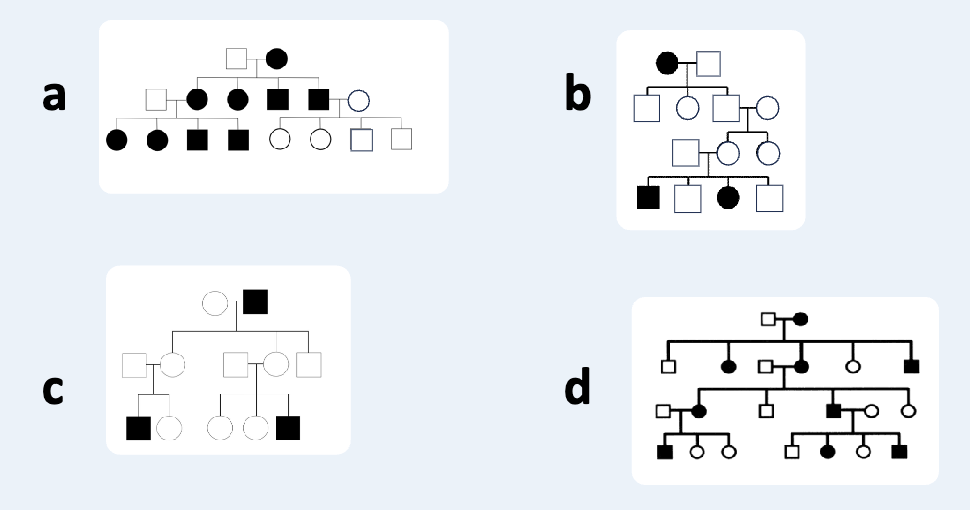
Which pedigree depicts an X-linked recessive pattern of inheritance?
C
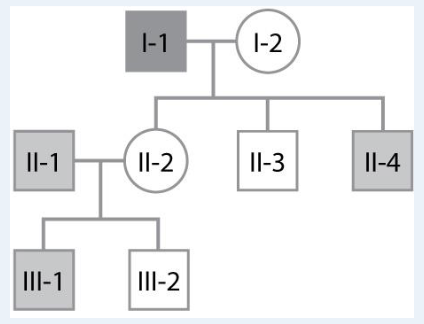
In the pedigree shown here, male I-1 has hemophilia and males II-1, II-4, and III-1 are red-green color blind. Both are X-linked recessive traits. What traits must female II-2 carry and why?
A. female II-2 must be a carrier for red-green colorblindness because her son III-1 has the trait
B. female II-2 must be a carrier for red-green colorblindness because her son III-1 has the trait and must be carrier of hemophilia because her father I-1 has the trait
C. female II-2 may be a carrier of hemophilia because her father I-1 has the trait but cannot be a carrier of red-green color blindness because her son -inherited it from his father (II-1)
D. there’s a 50/50 chance female II-2 is a carrier for red-green colorblindness because her son III-1 has the trait and a 50/50 chance she’s a carrier of hemophilia because her father I-1 has the trait
B. female II-2 must be a carrier for red-green colorblindness because her son III-1 has the trait and must be carrier of hemophilia because her father I-1 has the trait
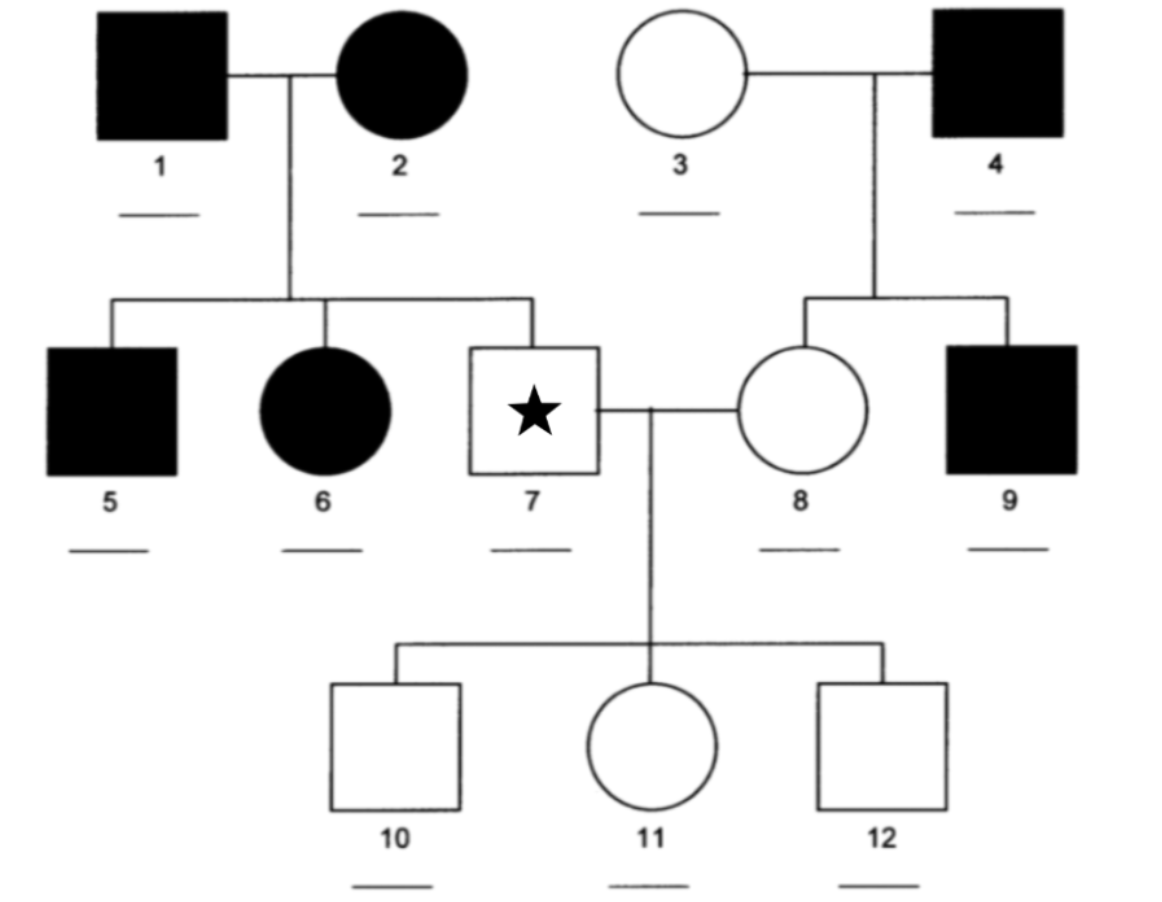
What is the genotype of the individual marked by a star?
Homozygous recessive
T/F: If two parents, both with autosomal dominant conditions, have a child, there is a 100% chance that the child will inherit the condition.
False
Describe how the inheritance of X-linked traits differs from the inheritance of autosomal traits.
A. Females are more likely to express X-linked traits than males since they have two X chromosomes, and therefore two chances to inherit an affected allele
B. All traits on the X chromosome are recessive, while Mendelian traits are always dominant
C. Males are more likely to express X-linked traits because they only have one X chromosome whereas females have two
D. Expression of X-linked traits is only applicable to females. Males do not express X-linked traits
C. Males are more likely to express X-linked traits because they only have one X chromosome whereas females have two
Duchenne muscular dystrophy, a disease-causing progressive muscle weakness, has an X-linked recessive pattern of inheritance. A mother carries a recessive allele for Duchenne muscular dystrophy but does not express the trait. She has three children, a daughter and two sons. What are the possible outcomes for the inheritance of the Duchenne muscular dystrophy trait in her children?
The daughter may only express the trait if her father is affected by Duchenne muscular dystrophy.
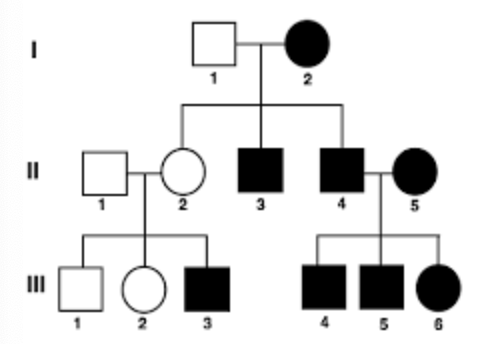
Given that male I-1 has no affected alleles, the inheritance pattern represented in the pedigree is most accurately described as…
X-linked recessive
Which of the reactions is most likely to be exergonic?
A. the synthesis of DNA daughter strand during DNA replication
B. the formation of cellulose from individual glucose molecules
C. the synthesis of a phospholipid from glycerol and fatty acids
D. the digestion of protein from food into amino acids
D. the digestion of protein from food into amino acids
breaking down something

T/F: Enzymes help endergonic chemical reactions go faster by reducing
the change in free energy between the reactants and the products.
False - can only reduce Ea
can’t affect delta G
Why is making ATP important for cells?
A. because ATP creates energy that can be used to fuel endergonic reactions
B. because ATP stores just the right amount of energy to drive endergonic reactions—enough to power them without being wasteful—and this energy is readily accessible through its high-energy phosphate bonds
C. because building ATP from ADP is an exergonic reaction that releases free energy the cell can use for driving endergonic reactions
D. because ATP can directly phosphorylate proteins, thereby activating them
B. because ATP stores just the right amount of energy to drive endergonic reactions—enough to power them without being wasteful—and this energy is readily accessible through its high-energy phosphate bonds
The goal of cellular respiration is to break down the food you eat and store the released energy in ATP. Is cellular respiration a catabolic or anabolic process?
A. catabolic
B. anabolic
catabolic
During the cell cycle, the cyclin/CDK complex phosphorylates target proteins that promote the cell cycle. This is an example of:
A. substrate-level phosphorylation
B. oxidative phosphorylation
C. neither
A. substrate-level phosphorylation
Substrate-level phosphorylation of ADP is …
A. more efficient than oxidative phosphorylation of
B. involves the transfer of a phosphate to a molecule of ADP
C. a way to produce ATP
D. two of the above
E. all of the above
D - two of the above (b and c)
T/F: Glycolysis involves both catabolic and anabolic reactions.
True - both
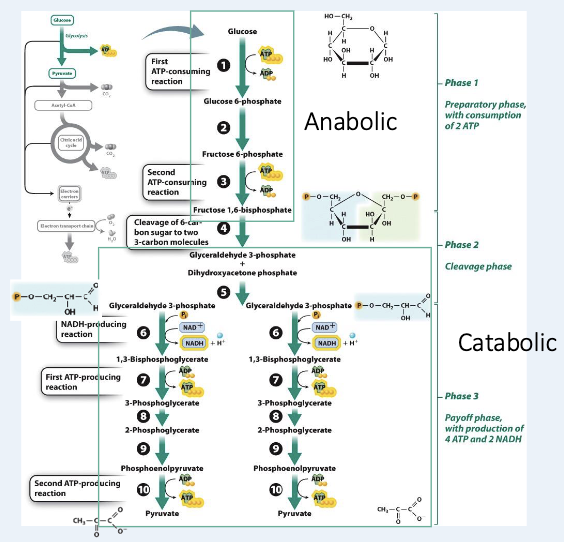
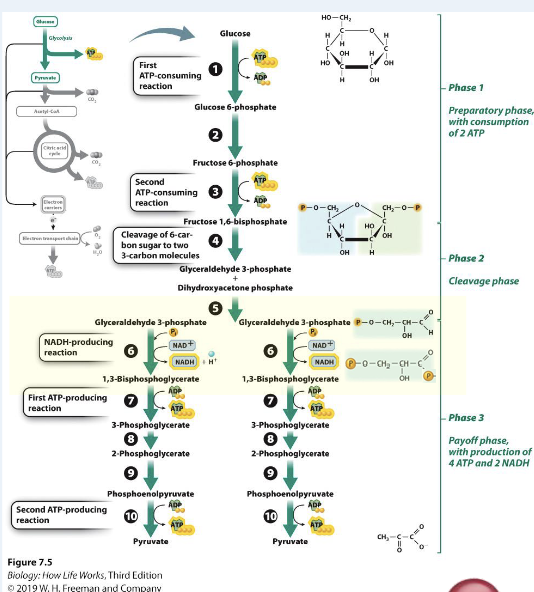
Why do you think that second phosphate (Pi) is first added to G3P (step 6) to make ATP (step 7), rather than just being added directly to ADP?
A. the phosphate encounters the G3P before ADP
B. because the the addition of the Pi can be coupled to the oxidation of G3P, making it an energetically favorable reaction
C. because the resulting 1,3- biphosphoglycerate (step 7) has high free energy and will therefore readily transfer its phosphate group to ADP (it’s exergonic)
D. both b and c
D. both b and c
The goal(s) of glycolysis is/are to …
A. start the process of catabolizing glucose
B. split glucose apart in 2 smaller molecules
C. transfer some of the energy stored in the bonds of the glucose
molecule to ATP and the electron carrier NADH
D. all of the above
D. ALL of the above
Y/N: Is glycolysis an aerobic process?
No - only the steps that take place in mitochondria
T/F: All aerobic processes in cellular respiration take place in the mitochondria.
True!
What type of phosphorylation produced ATP during the citric acid cycle?
A. substrate-level phosphorylation
B. oxidative phosphorylation
A. substrate-level phosphorylation
T/F: The citric acid cycle occurs in the cytoplasm.
False - mitochondria
During the citric acid cycle, the production of CO2 is the result of the _____ of acetyl coA (and its derivative compounds) during the cycle.
A. oxidation
B. reduction
C. neither
A. oxidation

Thinking about the energy transfers and transformations that have occurred
so far during glycolysis, pyruvate oxidation, and the citric acid cycle, which
of the following molecules has captured most of the free energy (G) from
the original glucose molecule? You may find the graph below helpful.
A. NADH
B. FADH2
C. CO2
D. ATP
A. NADH
Which of the following statements about carbohydrate anabolism is correct?
A. The reaction is not spontaneous
B. The reaction has a negative ΔG
C. The reaction requires ATP (energy) to proceed
D. A and B
E. A and C
E. A and C
You are starting your first day as a student researcher and are tasked with uncovering the role of a given protein that you believe may be an enzyme. You add the protein to a reaction with a ΔG of -181 kJ/mol that normally proceeds very slowly. Upon adding, you find that the reaction rate increases drastically. How would you interpret these results?
The protein is an enzyme; it reduces the activation energy of the reaction by stabilizing the transition state
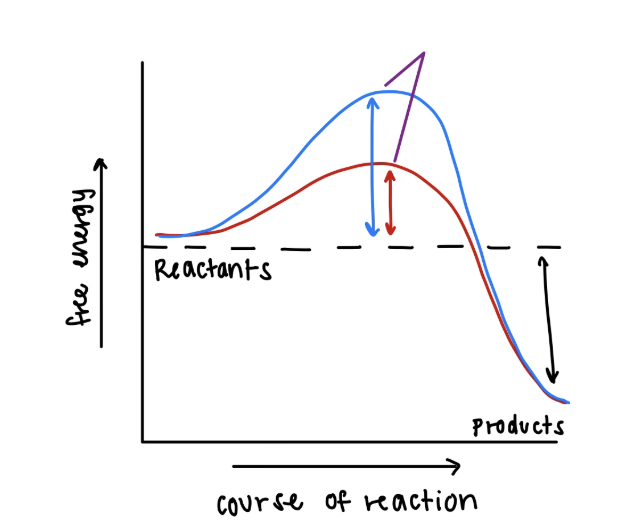
Jordan is lactose intolerant and has trouble digesting dairy products like milk and cheese. His doctor recommends Lactaid, a pill that contains the enzyme lactase, which helps break down lactose faster. Which point or part on the graph best represents the activation energy when Jordan does not take Lactaid?
the blue double arrow
Using the graph above, which point or part listed below represents the transition state?
I. peak of red curve
II. blue double arrow
III. red double arrow
IV. peak of blue arrow
both I and IV
T/F: ATP is involved in both catabolism and anabolism.
True
T/F: The sum of all molecule breakdowns throughout a cell’s lifetime is referred to as metabolism.
False
Which of the following is TRUE regarding glycolysis and the citric acid cycle?
A. Both require an input of ATP
B. Both produce a net of 2 ATP for every glucose molecule
C. Both processes are joined together by oxidative phosphorylation
D. Both store potential energy through chemical bonds
B. Both produce a net of 2 ATP for every glucose molecule
T/F: FADH2 stores more potential energy than ATP
True
Which of the following is true about the pyruvate oxidation step in aerobic cellular respiration?
A. requires oxygen (directly or indirectly)
B. takes place in mitochondrial matrix
C. involves substrate-level phosphorylation
D. A and B
E. A and C
A and B
T/F: By reducing NAD+, fermentation allows glycolysis to continue without oxygen.
False
A marathon runner is nearing the finish line. At this point, she feels an intense burning sensation in her muscles, indicating lactic acid buildup. Which of the following statements is true about fermentation in muscle cells during strenuous exercise?
A. Fermentation in muscle cells produces lactic acid, which regenerates NAD+ to allow glycolysis to continue producing ATP production in the absence of oxygen
B. Fermentation produces lactic acid, which is directly used to produce ATP in the absence of oxygen
C. Fermentation produces lactic acid, which halts glycolysis and allows the cell to dedicate energy expenditure to oxidative phosphorylation, producing a greater net ATP payoff
D. Fermentation produces lactic acid, which halts glycolysis and prevents the production of ATP in order to reserve cellular energy in the absence of oxygen
A. Fermentation in muscle cells produces lactic acid, which regenerates NAD+ to allow glycolysis
A marathon runner is at the starting line, and upon hearing the horn, she makes her way to the front of the group. Before oxygen is depleted, ATP can be produced via cellular respiration by substrate-level phosphorylation and oxidative phosphorylation. Which of these processes will most efficiently produce ATP to supply the high energy requirements of active muscle early in the race?
A. Substrate level phosphorylation, because the transfer of phosphates between molecules more efficiently produces large amounts of ATP
B. Oxidative phosphorylation, because oxidation of muscle tissue leads to signal amplification in ATP synthesis pathways
C. Substrate level phosphorylation, because enzymes are not necessary for this level of phosphorylation, and therefore the reaction can occur at a faster rate
D. Oxidative phosphorylation, because the series of redox reactions maximizes the released potential energy of electrons, generating more ATP
D. Oxidative phosphorylation, because the series of redox reactions maximizes the released potential energy of electrons, generating more ATP
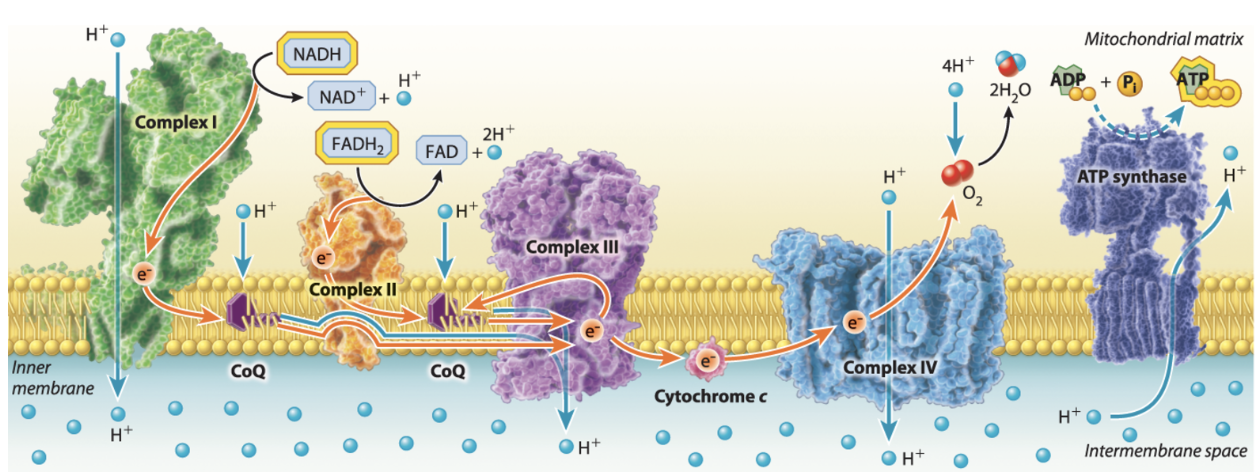
If there was a mutation in the ability of Coenzyme QH2 (CoQH2) to carry electrons, how would this impact oxidative phosphorylation?
A. ATP production would decrease because CoQH2 would be unable to transport electrons to Complex III
B. ATP production would decrease because Complex I would be inhibited from pumping protons
C. ATP production would increase because the mutation would inhibit CoQH2 from stealing electrons from the electron transport chain
D. ATP production would be unaffected because Cytochrome C3+ could take over the job of CoQH2
A. ATP production would decrease because CoQH2 would be unable to transport electrons to Complex III
Four enzymatic complexes span the mitochondrial inner membrane to comprise the electron transport chain and function to help generate a proton gradient for ATP production. Which of these four complexes does not directly involve pumping protons across the membrane?
complex II
T/F: Electrons extracted from the covalent bonds in glucose are transferred to the electron carriers NAD+ and FAD via reduction.
true
Which of the following roles does chemiosmosis play in producing ATP
I. Pump protons across the membrane
II. Generate electrochemical gradient
III. Release potential energy to power ATP synthetase
IV. Directly catalyzes ATP synthesis
III only
T/F: In oxidative phosphorylation, oxygen serves as the final electron acceptor in chemiosmosis, and its reduction to water helps maintain the flow of electrons
False
An electrochemical gradient is established across the inner mitochondrial membrane during cellular respiration. Which of the following most accurately describes how this gradient is formed?
A. The movement of electrons through the electron transport chain (ETC) establishes a charge difference across the membrane
B. The accumulation of protons (H+) in the mitochondrial matrix establishes a concentration gradient across the membrane
C. The pumping of protons (H+) into the intermembrane space creates both a charge and a concentration gradient
D. The movement of oxygen from the matrix to the intermembrane space creates both a charge and a concentration gradient
E. more than one above is correct
The pumping of protons (H+) into the intermembrane space creates both a charge and a concentration gradient
If 2 traits show a Mendelian pattern of inheritance, which is true?
if double heterozygotes mate, the offspring will have 9:3:3:1 phenotype ratio
double heterozygotes will phenotypically express both dominant traits
the genes for these traits will assort independently of each other
genes for these traits must be located on autosomes
T/F: The random orientation of sister chromatids during metaphase I directly explains the principle of segregation.
False - anaphase I
T/F: the principle of independent assortment reflects the fact that homologous chromosomes align randomly during metaphase I
true - metaphase I
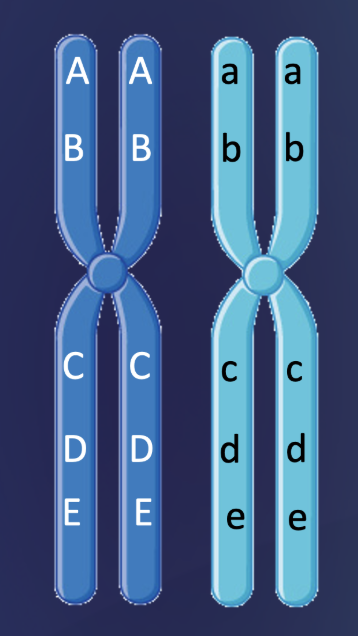
T/F: recombination between genes A & D is less likely than recombination between D & E
False - more likely

shell and eye genes are LINKED (must have inherited together)
GB (dad) and gb (mom)
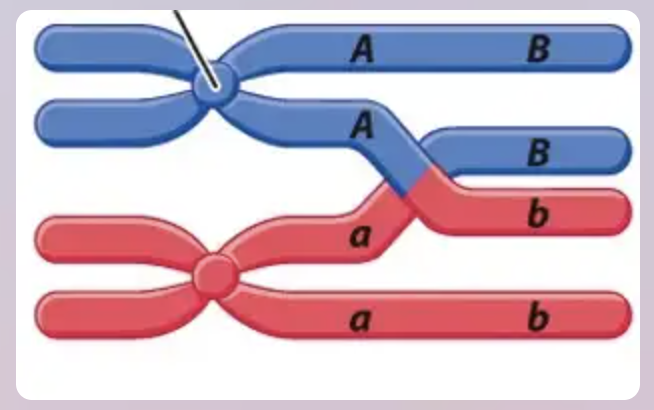
This crossover event would result in…
A. linkage of genes A and B
B. gametes with wither Ab or aB
C. independent assortment of genes A and B
D. gametes with either AB or ab
independent assortment of genes A and B
T/F: if a crossover event occurs outside the space between two genes, then all 4 chromatids will be fully NONrecombinant
False - if a crossover event happened, there will be recombination. its just not in the genes we are interested in
What is true about X-linked inheritance?
affected sons must have a mom with an affected allele (bc mom gives son the X allele and sons only need one mutant allele to be affected)
affected daughters must have a mom with an affected allele
affected daughter must have a dad with an affected allele
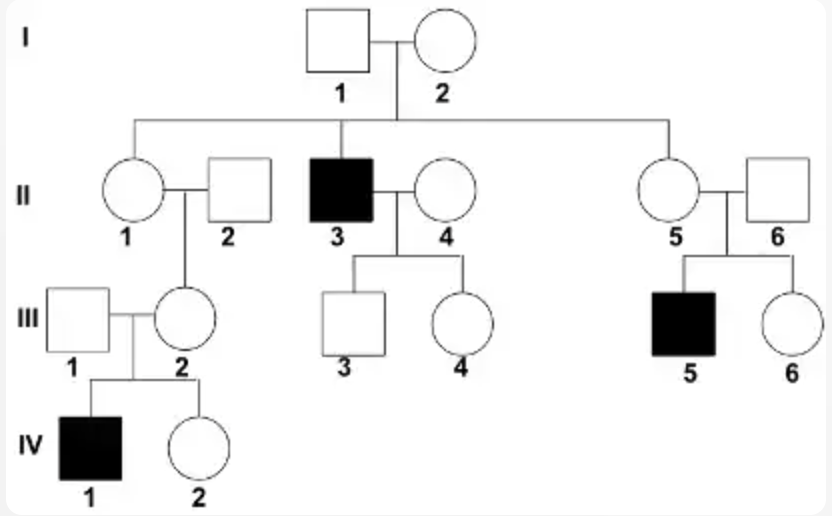
T/F: most likely autosomal recessive
false - only males are affected so X-linked?
What is true about autosomal dominant inheritance?
one copy of a mutant allele is enough to express the trait
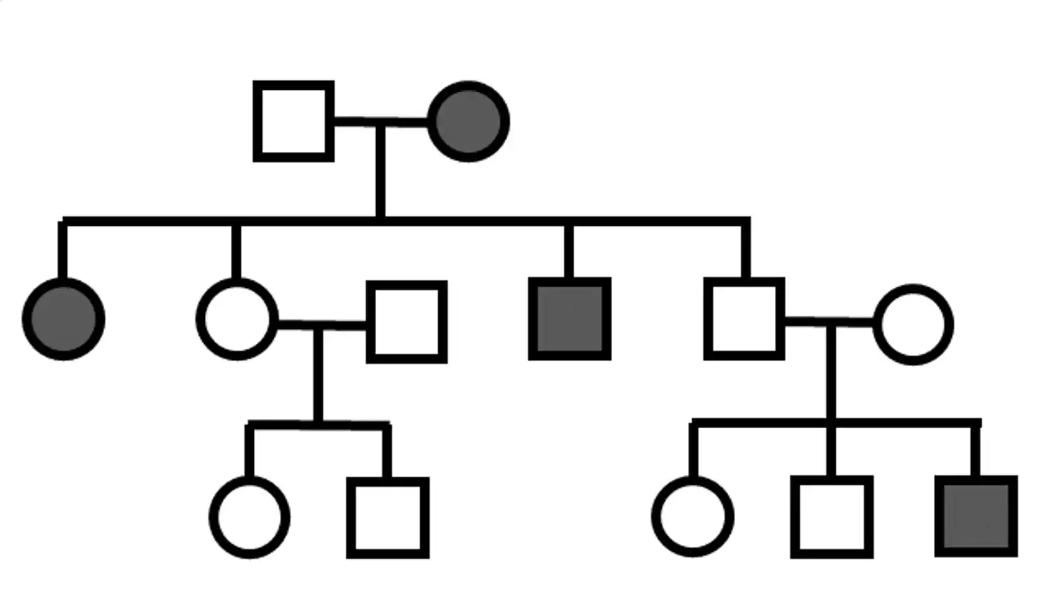
pedigree shows …
autosomal recessive
on right side, two unaffected parents have an affected son
T/F: in autosomal dominant inheritance, two affected parents can have unaffected offspring.
true - heterozygous
What is true about endergonic rxns?
require energy
positive delta G
How do enzymes speed up reactions?
lower Ea
stabilize transition state
put the stages of cellular respiration in order
glycolysis
pyruvate oxidation
citric acid cycle
oxidative phosphorylation
which of the following rxns are exergonic?
a. phosphorylation of ADP to produce ATP
b. addition of 2 phosphates to glucose during glycolysis
c. transfer of electrons from g3p (glucose derivative) to NAD+ in glycolysis
d. none
transfer of electrons from g3p (glucose derivative) to NAD+ in glycolysis
what is energetic coupling?
use of energy released by exergonic rxn to drive endergonic rxn
T/F: during glycolysis, all the PE in glucose is extracted from its chemical bonds and stored in ATP and NADH.
FALSE - that is why we need an intermediate stage (aka pyruvate oxidation)
what does fermentation do?
replenishes NAD+ for another round of glycolysis
in which stage is the original glucose molecule fully oxidizes?
citric acid cycle - now in electron carriers
what is the term used to describe the direct transfer of phosphate group from one molecule to another?
substrate-level phosphorylation
ATP is produced by substrate-level phosphorylation in which steps of cell respiration?
all the steps before oxidative phosphorylation
answer: glycolysis and citric acid cycle
NOT pyruvate oxidation bc its an intermediate step and ATP isn’t actually produced
when do redox rxns occur in cellular respiration?
ALL THE TIME
glycolysis, pyruvate oxidation, citric acid cycle, oxidative phosphorylation
what do complexes in the ETC do?
pump protons across the inner membrane
carry out multiple energy releasing redox rxns
transform energy from electrons into an electrochemical gradient
oxidize NADH and FADH2
what is chemiosmosis
using flow of protons down electrochem. gradient to power ATP synthesis
a mutation in which complex would directly lead to a buildup of FADH2 and eventually oxygen
complex II